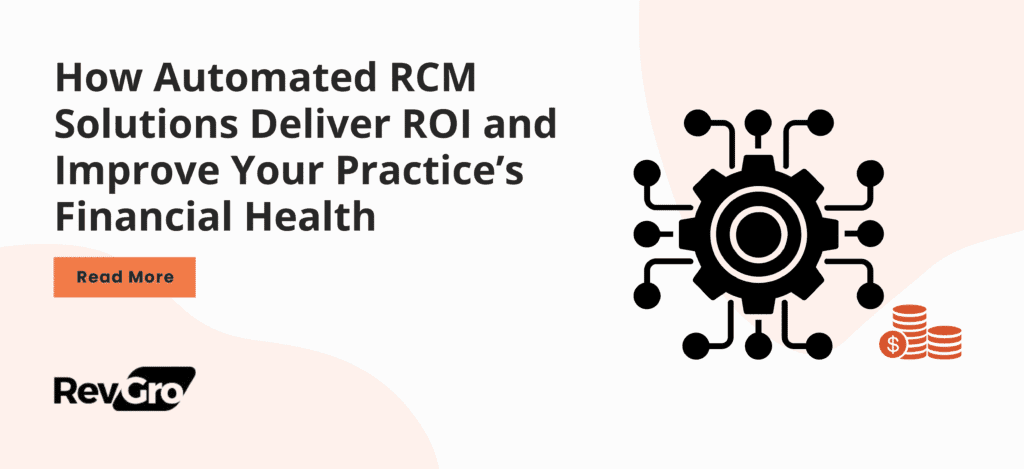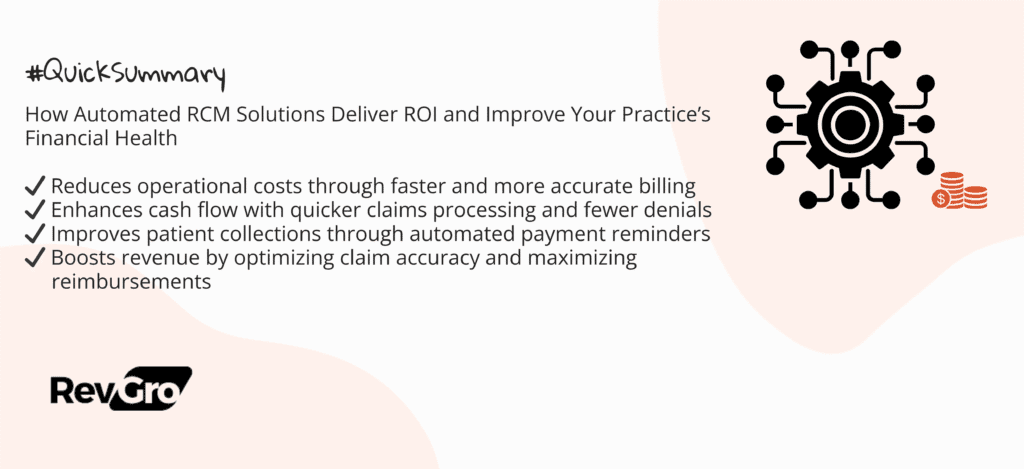
- Understanding the RCM Process and Its Impact on Your Practice
- How Automated RCM Solutions Drive ROI
- Improving Cash Flow with Automated RCM
- Enhanced Patient Satisfaction with Transparent Billing
- Data-Driven Insights for Continuous Improvement
- The ROI of Implementing Automated RCM: Real-World Examples
- Conclusion: How Automated RCM Can Transform Your Practice’s Financial Health

How Automated RCM Solutions Deliver ROI and Improve Your Practice’s Financial Health
In today’s fast-paced healthcare environment, medical practices are increasingly looking for ways to optimize their revenue cycle management (RCM) to ensure financial stability and sustainable growth. One of the most effective ways to enhance the financial health of your practice is through automating the RCM process. By leveraging automation, practices can achieve faster reimbursements, reduce denial rates, and streamline billing workflows, all while improving cash flow and boosting profitability.
This blog will explore how automated RCM solutions can provide a strong return on investment (ROI), improve cash flow, and ultimately strengthen your practice’s financial health.
Revenue Cycle Management (RCM) refers to the series of processes that healthcare providers use to track patient care from the initial appointment through to final payment. This includes scheduling, coding, billing, insurance claims processing, and payment collections.
For many practices, inefficient RCM processes can lead to delays in payment, claim denials, administrative errors, and lost revenue. The sheer complexity of managing these tasks manually can place a significant burden on staff, leading to increased operational costs and decreased cash flow.
However, automation of RCM processes offers an innovative solution to these challenges, ultimately improving both the efficiency and effectiveness of the revenue cycle.
Reduced Operational Costs
Manual RCM processes are not only time-consuming but also prone to errors. Human involvement in billing, coding, and claims submission often leads to missed deadlines, incorrect coding, and billing mistakes. These errors can delay payments, increase administrative costs, and lead to unnecessary denials.
Automated RCM solutions reduce human intervention, enabling faster and more accurate processes. By automating claims submissions, coding verification, and payment processing, practices can significantly cut down on operational costs and reduce the need for manual oversight. These cost savings directly contribute to improved profitability and a stronger ROI.
Faster Reimbursements
One of the primary benefits of automating RCM is the speed at which claims are processed and reimbursed. Automated RCM systems use real-time data to process claims instantly, eliminating the need for manual follow-ups. This reduces the overall claim cycle time, allowing practices to receive faster reimbursements and improve cash flow.
Automation also ensures that claims are submitted without errors, increasing the likelihood that claims will be approved on the first submission. In fact, studies have shown that practices using automated systems experience fewer claim denials, which directly results in timelier payments and a higher revenue collection rate.
Minimizing Claim Denials
Claim denials are a major obstacle for many healthcare providers. The average denial rate in the healthcare industry is estimated at around 8-10%, with some practices experiencing even higher rates. These denials lead to delays in reimbursement and additional administrative work to resubmit claims.
Automated RCM solutions significantly reduce the likelihood of denied claims by performing real-time checks for errors in coding, patient eligibility, and payer requirements. This proactive approach ensures that claims are correctly filed the first time, reducing the need for time-consuming resubmissions and ultimately accelerating the payment process.
Improving Patient Collections
Patient collections have become an increasingly important part of the RCM process, especially with the rise in high-deductible health plans and patient responsibility for payments. Automated RCM systems streamline patient billing and collections by sending automated reminders and offering multiple payment options (e.g., online payments, installment plans, auto-pay).
With these tools in place, patients are more likely to pay on time, resulting in improved collections and more consistent cash flow. Additionally, automated systems can offer detailed billing statements and payment portals, increasing transparency and reducing the likelihood of payment disputes.
Enhanced Patient Satisfaction with Transparent Billing
Automation doesn’t just benefit your practice’s bottom line—it also improves patient satisfaction. Clear communication and accurate billing are key to fostering patient trust and loyalty. Automated RCM systems provide patients with real-time access to their billing information and payment history, allowing them to better understand their financial responsibility and reducing confusion.
Furthermore, by implementing automated appointment reminders and follow-ups, practices can reduce no-show rates and improve overall patient engagement. When patients have a seamless billing experience and the ability to track payments easily, they are more likely to feel satisfied with your practice, leading to higher patient retention rates.
Data-Driven Insights for Continuous Improvement
One of the key advantages of automated RCM systems is the access to real-time analytics and reporting. These systems provide valuable insights into your practice’s financial performance, allowing you to track denial rates, collections, and reimbursement cycles. With this data, you can make informed decisions about how to further improve your RCM processes.
For example, by identifying patterns in denied claims, you can proactively address recurring issues such as coding errors or payer-specific requirements. Additionally, automated systems can offer predictive analytics, helping you forecast future revenue cycles, cash flow trends, and operational bottlenecks. This ensures that your practice is always prepared for financial changes and is consistently maximizing revenue potential.
Let’s take a look at some real-world examples of how automated RCM has helped healthcare practices achieve significant ROI:
- Example 1: A multi-specialty clinic implemented an automated RCM system and saw a 20% reduction in claim denials within the first 6 months. This led to faster reimbursements and an increase in revenue by 15% within the first year.
- Example 2: A solo practitioner used automation to streamline patient collections, resulting in a 30% improvement in collections and a 25% increase in cash flow over a 12-month period.
These examples show that automated RCM systems are not just a cost-saving tool—they are a revenue-generating asset for healthcare providers.
Automating your RCM processes is no longer just a luxury—it’s a necessity for healthcare practices looking to improve cash flow, reduce operational costs, and enhance overall financial health. By automating claims management, billing, and patient collections, practices can see a significant return on investment in terms of faster reimbursements, reduced denials, and higher revenue.
Investing in automated RCM solutions ensures that your practice remains efficient, compliant, and financially healthy, ultimately allowing you to focus on delivering high-quality patient care.
Ready to boost your revenue by 25% like our other clients? Book a 15-min demo with our RCM experts today.
